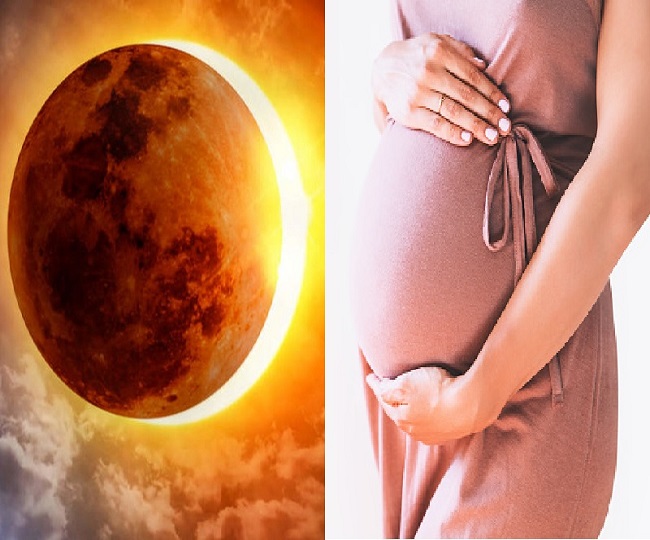


This article discusses the impact of a total solar eclipse on pregnant women and offers tips for staying safe during the event. It advises expectant mothers to stay indoors and avoid direct contact with the sun's rays, while also providing precautions for those who need to go outside. Additional advice includes staying hydrated and seeking professional guidance from a healthcare provider before the eclipse.
A total solar eclipse is a rare and awe-inspiring event. However, for pregnant women, it's important to take extra precautions to ensure the safety of both mother and baby.
During a total solar eclipse, the moon passes directly between the Earth and the sun, blocking out all direct sunlight. This can create a dramatic drop in temperature and a sudden surge in ultraviolet (UV) radiation.
UV Radiation and Pregnancy
UV radiation is a type of electromagnetic radiation that can be harmful to both pregnant women and their unborn children. UV radiation can damage the skin and increase the risk of sunburn, aging, and skin cancer. It can also penetrate the uterus and damage the developing fetus.
Pregnant women are particularly vulnerable to UV radiation because their skin is more sensitive and their immune systems are weakened. Exposure to high levels of UV radiation during pregnancy can increase the risk of:
Precautions for Pregnant Women
To protect themselves and their unborn children, pregnant women should take the following precautions during a total solar eclipse:
FAQs
1. What are the risks of solar eclipse for pregnant women?
Exposure to high levels of UV radiation during pregnancy can increase the risk of birth defects, preterm birth, low birth weight, and developmental disorders.
2. What are the symptoms of UV radiation exposure?
Symptoms of UV radiation exposure can include sunburn, redness, itching, swelling, and peeling. In severe cases, UV radiation exposure can lead to heat stroke, dehydration, and other health problems.
3. How long does it take for UV radiation to cause damage?
UV radiation can damage the skin within minutes. It is important to protect yourself from UV radiation even on cloudy days.
4. What are the best ways to protect myself from UV radiation during a solar eclipse?
The best ways to protect yourself from UV radiation during a solar eclipse are to stay indoors, wear protective clothing, and avoid direct contact with the sun's rays.
5. What should I do if I think I have been exposed to too much UV radiation?
If you think you have been exposed to too much UV radiation, seek medical attention immediately. UV radiation exposure can lead to serious health problems if not treated promptly.

In this edition of Health360, a renewed debate over the alleged link between vaccines and autism is sparked by tech mogul Sridhar Vembu's endorsement of a questionable study. Despite reassurances from the medical community backed by data from the WHO, doubts continue to persist, leading to potential harm to public health. The program also delves into the alarming rise in back pain cases in India and explores new treatments.

In an effort to fight the ongoing air pollution crisis, Delhi conducted its first-ever official cloud seeding operation led by IIT Kanpur. The operation involved a small aircraft dispersing specially designed chemical flares into the atmosphere to create rain. While experts say rainfall could occur within 15 minutes to 4 hours, the actual timeframe depends on various factors such as wind direction and moisture content. If successful, the government plans to continue the operation in the coming days.

In the quest for stronger, luscious hair, we often overlook the importance of nurturing the roots. Fortunately, Ayurveda has long stressed the significance of this practice, which has now been backed by modern science. Studies have shown that herbs like Bhringraj and Amla can activate hair follicles, promoting new growth and delaying greying. Fenugreek, Neem, Hibiscus, and Ashwagandha are also found to be beneficial in strengthening and nourishing the scalp, resulting in thicker and healthier hair.

A college student shares her personal journey of becoming a vegetarian, despite facing challenges and health concerns. She then delves into an ethics class she took, where the concept of marginal cases were discussed. Following an article by philosophy professor Alastair Norcross, she concludes that even though individual action may seem insignificant, refusing to consume factory-farmed meat holds moral significance due to the potential to prevent immense suffering for animals.

On October 24, the global community commemorates World Polio Day to honor the legacy of Dr. Jonas Salk and the efforts of countless individuals and organizations in the fight against polio. This highly contagious and potentially deadly disease, once a widespread epidemic, is now largely preventable thanks to the development of a life-saving vaccine. India's successful eradication of polio serves as a testament to the importance of strong vaccination programs and collaborations in public health initiatives.

As winter arrives in India, so does the hazardous air pollution. Delhi NCR's AQI has already crossed the 400 mark, making it crucial to invest in air purifiers, especially after Diwali. Dyson, Qubo, HomePure, and Philips have launched high-quality air purifiers with advanced features to tackle different types of pollutants and create cleaner indoor air. With prices ranging from Rs 5,000 to Rs 1 lakh, these purifiers are a practical and timely purchase for a healthier living.

In a recent family vlog, Indian celebrity couple Shoaib Ibrahim and Dipika Kakar shared their "natural" hair care routine for their son, using a homemade mask made with rice flour, flax seeds, and coconut oil. However, experts warn that what works for adults may not be suitable for babies, whose sensitive skin and scalp could react to the ingredients. While the ingredients may improve hair texture, they do not necessarily promote hair growth. Instead, a healthy diet and good scalp care are more important in maintaining healthy hair.

A recent consumer study has found multiple brands of soft contact lenses in the U.S. to contain "forever chemicals" that can be harmful to both the body and the environment. The study, conducted by the nonprofit organization Environmental Health Sciences, tested 18 varieties of popular contact lenses and found all of them to contain markers for PFAS. Brands such as Acuvue, Alcon, and CooperVision were among the list of affected products. This news serves as a cautionary lesson on the potential risks of overusing contact lenses.

On the birth anniversary of Dr. APJ Abdul Kalam, the ‘Missile Man’ of India, tributes pour in on social media celebrating his life, vision and impact. A visionary scientist, inspiring leader and true patriot, Dr. Kalam's humility, compassion and constant interaction with students continue to inspire generations. His tireless efforts in defense, science and youth empowerment have strengthened India's path towards self-reliance and his legacy continues to motivate young minds to dream big and work hard for the nation.

Recent studies have found that extreme heat, particularly when combined with high humidity, can have a significant impact on mental health. A study in India showed that when wet bulb temperature exceeded 27°C, the probability of reporting severe depression increased by 0.5%, even when the temperature was slightly lower. This finding is consistent with global reviews that have linked high temperatures to mood disorders, increased hospital admissions for psychiatric conditions, and even elevated suicide risk. The Lancet has also published evidence that rising temperatures worldwide are a growing threat to emotional and cognitive health.